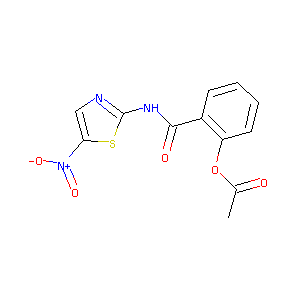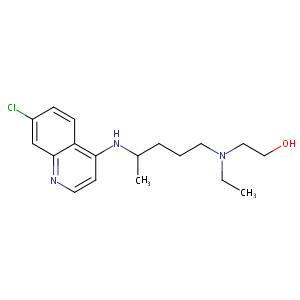| 1 |
ClinicalTrials.gov (NCT04361318) Hydroxychloroquine and Nitazoxanide Combination Therapy for COVID-19. U.S. National Institutes of Health.
|
| 2 |
Nitazoxanide FDA Label
|
| 3 |
Drugs@FDA. U.S. Food and Drug Administration. U.S. Department of Health & Human Services. 2015
|
| 4 |
ClinicalTrials.gov (NCT04382846) Novel Regimens in COVID-19 Treatment. U.S. National Institutes of Health.
|
| 5 |
Hydroxychloroquine FDA Label
|
| 6 |
URL: http://www.guidetopharmacology.org Nucleic Acids Res. 2015 Oct 12. pii: gkv1037. The IUPHAR/BPS Guide to PHARMACOLOGY in 2016: towards curated quantitative interactions between 1300 protein targets and 6000 ligands. (Ligand id: 7198).
|
| 7 |
ClinicalTrials.gov (NCT04341727) Hydroxychloroquine,Hydroxychloroquine,Azithromycin in the Treatment of SARS CoV-2 Infection (WU352). U.S. National Institutes of Health.
|
| 8 |
Drugs@FDA. U.S. Food and Drug Administration. U.S. Department of Health & Human Services.
|
| 9 |
The anti-hepatitis C agent nitazoxanide induces phosphorylation of eukaryotic initiation factor 2alpha via protein kinase activated by double-stranded RNA activation. Gastroenterology. 2009 Nov;137(5):1827-35. doi: 10.1053/j.gastro.2009.07.056. Epub 2009 Aug 4.
|
| 10 |
Identification of Modulators That Activate the Constitutive Androstane Receptor From the Tox21 10K Compound Library. Toxicol Sci. 2019 Jan 1;167(1):282-292. doi: 10.1093/toxsci/kfy242.
|
| 11 |
Population-based in vitro hazard and concentration-response assessment of chemicals: the 1000 genomes high-throughput screening study. Environ Health Perspect. 2015 May;123(5):458-66. doi: 10.1289/ehp.1408775. Epub 2015 Jan 13.
|
| 12 |
Remdesivir and chloroquine effectively inhibit the recently emerged novel coronavirus (2019-nCoV) in vitro. Cell Res. 2020 Mar;30(3):269-271.
|
| 13 |
TLR7/9 antagonists as therapeutics for immune-mediated inflammatory disorders. Inflamm Allergy Drug Targets. 2007 Dec;6(4):223-35.
|
| 14 |
Mechanisms of action of hydroxychloroquine and chloroquine: implications for rheumatology. Nat Rev Rheumatol. 2020 Mar;16(3):155-166.
|
| 15 |
MDR-ABC transporters: biomarkers in rheumatoid arthritis. Clin Exp Rheumatol. 2013 Sep-Oct;31(5):779-87.
|
| 16 |
Hydroxychloroquine: a physiologically-based pharmacokinetic model in the context of cancer-related autophagy modulation. J Pharmacol Exp Ther. 2018 Jun;365(3):447-459.
|
| 17 |
Somer M, Kallio J, Pesonen U, Pyykko K, Huupponen R, Scheinin M "Influence of hydroxychloroquine on the bioavailability of oral metoprolol." Br J Clin Pharmacol 49 (2000): 549-54. [PMID: 10848718]
|
| 18 |
Hydroxychloroquine-inhibited dengue virus is associated with host defense machinery. J Interferon Cytokine Res. 2015 Mar;35(3):143-56. doi: 10.1089/jir.2014.0038. Epub 2014 Oct 16.
|
| 19 |
Hydroxychloroquine potentiates Fas-mediated apoptosis of rheumatoid synoviocytes. Clin Exp Immunol. 2006 Jun;144(3):503-11. doi: 10.1111/j.1365-2249.2006.03070.x.
|
| 20 |
Hydroxychloroquine inhibits CD154 expression in CD4(+) T lymphocytes of systemic lupus erythematosus through NFAT, but not STAT5, signaling. Arthritis Res Ther. 2017 Aug 9;19(1):183. doi: 10.1186/s13075-017-1393-y.
|
| 21 |
Chloroquine and Hydroxychloroquine Increase Retinal Pigment Epithelial Layer Permeability. J Biochem Mol Toxicol. 2015 Jul;29(7):299-304. doi: 10.1002/jbt.21696. Epub 2015 Mar 9.
|
| 22 |
Hydroxychloroquine decreases human MSC-derived osteoblast differentiation and mineralization in vitro. J Cell Mol Med. 2018 Feb;22(2):873-882. doi: 10.1111/jcmm.13373. Epub 2017 Oct 3.
|
| 23 |
Mitochondrial membrane permeabilization is a critical step of lysosome-initiated apoptosis induced by hydroxychloroquine. Oncogene. 2003 Jun 19;22(25):3927-36. doi: 10.1038/sj.onc.1206622.
|
| 24 |
Attenuation of chloroquine and hydroxychloroquine on the invasive potential of bladder cancer through targeting matrix metalloproteinase 2 expression. Environ Toxicol. 2021 Nov;36(11):2138-2145. doi: 10.1002/tox.23328. Epub 2021 Jul 19.
|
| 25 |
Reactive oxygen species mediate chloroquine-induced expression of chemokines by human astroglial cells. Glia. 2004 Jul;47(1):9-20. doi: 10.1002/glia.20017.
|
| 26 |
d-galactose induces premature senescence of lens epithelial cells by disturbing autophagy flux and mitochondrial functions. Toxicol Lett. 2018 Jun 1;289:99-106. doi: 10.1016/j.toxlet.2018.02.001. Epub 2018 Feb 6.
|
| 27 |
Antagonist-mediated down-regulation of Toll-like receptors increases the prevalence of human papillomavirus infection in systemic lupus erythematosus. Arthritis Res Ther. 2012 Apr 18;14(2):R80. doi: 10.1186/ar3803.
|
| 28 |
ClinicalTrials.gov (NCT04341493) Hydroxychloroquine vs Nitazoxanide in Patients With COVID-19
|
|
|
|
|
|
|


